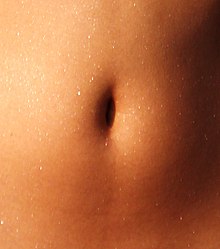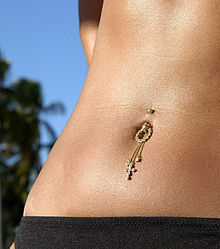belly button
The navel or navel (Latin umbilicus , Greek omphalos , Latin also anulus umbilicalis , literally the umbilical ring ) arises in all placentates (higher mammals, but not in marsupials ) after their birth. However, it can hardly be seen except in primates including humans. It is the point in the middle of the front of the abdomen where the umbilical cord grew out during pregnancy as it grew up in the womb , which exchanges the substances necessary for life and growth with the mother's bloodstream via the placenta .
After the birth and removal of the umbilical cord, the navel grows together and closes. It can be called the only physiological scar , since the umbilical cord is tissue from the embryo, not the mother.
Navel in humans
There are different visual manifestations of belly buttons. The development depends on many factors: genetic conditions, condition of the abdominal muscles, handling of the navel after birth, physical stress, etc. Basically, a distinction can be made between the convex plate-like navel turned outwards and the more often inward-turned navel. The inward-facing one can have even, concentric folds on the inside, two cheek-like bulges approaching one another or irregular adhesions. If the abdomen is more pronounced, it appears as a larger depression.
The navel becomes medically relevant in the event of inflammation, e.g. B. due to poor hygiene or umbilical hernias ( hernia ). An umbilical hernia makes it advisable to see a doctor, as abdominal organs can become trapped in the umbilical hernia. While an umbilical hernia existing in infancy usually grows together in the first years of life, existing umbilical hernias do not disappear after puberty.
Minimally invasive surgical procedures often use the navel as part of laparoscopic single-access surgery to insert instruments into the patient's abdomen via an adapter. Although the cosmetic consequences of this procedure are in the patient's interest, such keyhole operations take longer and the freedom of movement for the surgical instruments is restricted. Whether an operation is carried out through the navel depends on the surgeon's individual assessment.
The female navel is widely regarded as an erotic symbol. According to the Hays Code , Hollywood productions were not allowed to show actresses' belly buttons until the mid-1970s. Belly-free tops were generally allowed, but the navel had to be hidden. So it came about that the leading actress in the US series The Charming Jeannie , Barbara Eden , always had to cover her navel with her outfit.
Umbilical abnormalities and diseases
Umbilical abnormalities
A navel anomaly is a congenital disorder in the area of the navel.
- Amniotic umbilicus: Here the amniotic envelope extends over the abdominal skin, so that after the umbilical cord falls off , a rounded skin defect develops that granulates and thus usually heals without complications.
- Skin or flesh navel: The reverse case occurs here: The abdominal skin extends to the umbilical cord, so that after it falls off, a blunt umbilicus forms and this more or less clearly protrudes above the skin level.
In the case of Siamese twins , the children can grow together in the area of the navel. This double malformation is known as omphalopagos .
Umbilical bleeding
| Classification according to ICD-10 | |
|---|---|
| P38 | Newborn omphalitis, with or without easy bleeding |
| P51 | Umbilical hemorrhage in the newborn |
| P51.0 | Massive umbilical hemorrhage in the newborn |
| P51.8 | Other umbilical bleeding in the newborn |
| P51.9 | Umbilical hemorrhage in the newborn, unspecified |
| ICD-10 online (WHO version 2019) | |
Umbilical bleeding in newborns - ICD-10 : P51 - is usually a less serious event in which bleeding occurs from the base of the umbilical which has not yet epithelialised. If the cause is loosening of the umbilical ligature , this is classified as P51.8. Serious (massive) umbilical hemorrhages require further investigation. The cause is a coagulation disorder or abnormal pressure conditions in the umbilical cord vessels, as can occur with heart defects . Umbilical bleeding due to an inflamed umbilical cord ( omphalitis ) is classified under P38.
pregnancy
During the third trimester of pregnancy , the navel often turns outwards, but usually returns to its original position after birth.
Umbilical hernia
An umbilical hernia is usually a symptom-free, constantly curved umbilicus. For cosmetic reasons, surgical interventions are occasionally carried out to adapt to the "norm picture".
scabies
The sheltered, warm navel cavity is liked by itch mites sought for their unnoticed reproduction.
Sister Mary Joseph knot
A palpable, new, often painful lump on the navel can be a metastasis of a malignancy of the abdominal cavity, in the case of gastric cancer, intestinal cancer, ovarian cancer, etc. It spreads directly through the abdominal cavity, for example in the case of peritoneal carcinosis , or by lymphatic route .
Sister Mary Joseph was a nun and her real name was Julia Dempsey (* May 14, 1856, † March 29, 1939). She was the longtime surgical assistant to William James Mayo at Saint Mary's Hospital in Rochester , Minnesota , pointing out the link to abdominal tumors. The name after Sister Mary Joseph goes back to an article by Hamilton Bailey from 1949.
Belly button jewelry
To decorate the belly button is used since the late 20th century in the Western industrialized countries piercings , usually from a skin-compatible metal alloy. Similar decorations are known from early and archaic cultures.
Plastic surgery (umbilicoplasty)
Belly button corrections are offered as cosmetic surgery. While the shape of the belly button is determined at birth , it can change over time due to, for example, pregnancy and weight changes. The plastic surgery provides a method called on Umbilicoplastik with which produced the previous shape of the belly button again or patient desires can be improved in accordance with.
See also
Web links
Individual evidence
- ↑ http://www.geo.de/GEOlino/kreativ/haben-katzen-einen-bauchnabel-58762.html
- ^ R. Sinha, M. Sundaram, C. Mahajan, S. Raje, P. Kadam, G. Rao, P. Shitut: Single-incision total laparoscopic hysterectomy. In: Journal of minimal access surgery. Volume 7, number 1, January 2011, pp. 78-82, doi: 10.4103 / 0972-9941.72389 , PMID 21197248 , PMC 3002013 (free full text).
- ↑ Marika Surace: The World's Belly Button. In: vogue.it. Retrieved March 11, 2017 (Italian).
- ↑ navel during pregnancy
- ↑ Scabies in the navel
- ↑ Javier Barambio, Lorena Brandariz: An umbilical nodule New England Journal of Medecine 2019, Volume 380, Issue 11 of March 14, 2019, page 1061, DOI: 10.1056 / NEJMicm1809024
- ↑ M. Abu-Hilal, JS Newman: Sister Mary Joseph and her nodule: historical and clinical perspective . American Journal of Medical Science 2009, Volume 337, Issue 4, Pages 271-273, doi: 10.1097 / MAJ.0b013e31819541
- ↑ Hamilton Bailey: Demonstration of physical signs in clinical surgery . 11th edition 1949, Williams & Wilkins Verlag, Baltimore (USA), page 227
- ↑ elle.de: Beautiful Bellybutton !? Everything about the controversial trend towards navel surgery
- ↑ dariusalamouti.de: navel correction, umbilicoplasty




